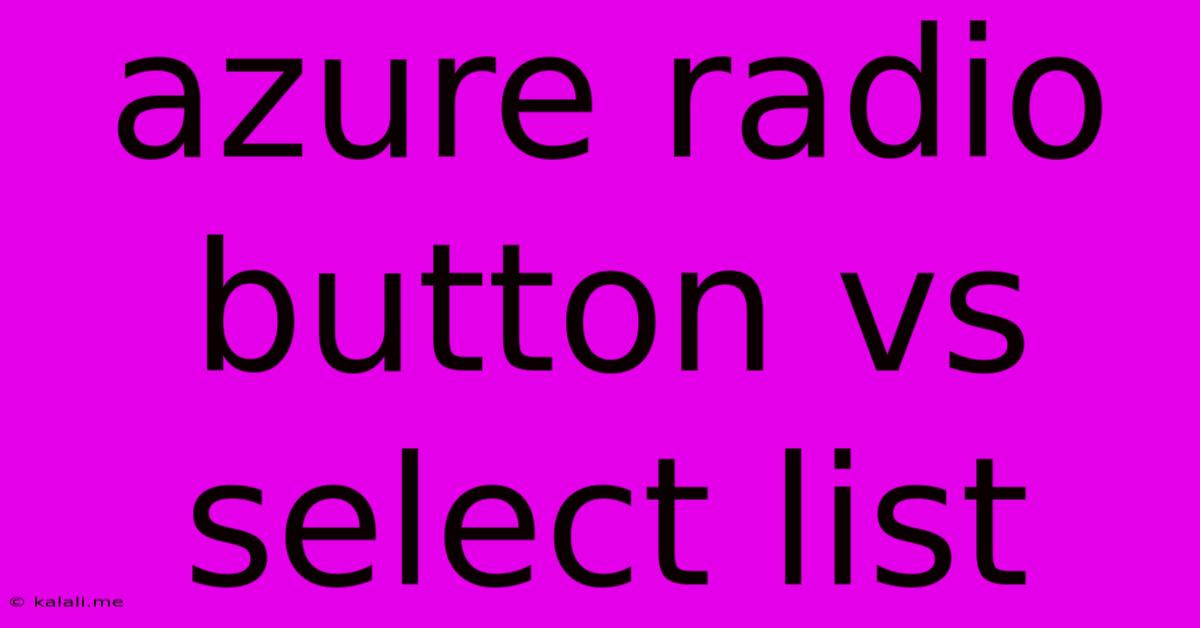Azure Radio Button Vs Select List
Kalali
May 29, 2025 · 3 min read

Table of Contents
Azure Radio Button vs. Select List: Choosing the Right Control for Your Forms
Choosing the right UI control can significantly impact the user experience and the effectiveness of your forms. In Azure, both radio buttons and select lists (also known as dropdown lists) offer ways for users to make single selections, but they cater to different scenarios and have distinct advantages and disadvantages. This article will delve into the key differences between Azure radio buttons and select lists, helping you decide which control best suits your application's needs. We'll explore usability, accessibility, and coding considerations to ensure you make an informed decision.
Understanding the User Experience:
The primary difference lies in how each control presents choices to the user. Radio buttons display all options visibly, allowing for a quick scan and selection. Select lists, conversely, present a single visible selection area with an arrow to reveal a list of options. This compact nature is beneficial when dealing with a large number of options, preventing visual clutter.
When to Use Radio Buttons:
- Few options: Radio buttons shine when presenting a small number of mutually exclusive choices (e.g., gender, payment method). Their clear visual presentation simplifies decision-making.
- Visual clarity and importance: When each option needs equal visual prominence, radio buttons excel. They provide a clear and concise way to present choices, ensuring all options are easily seen and considered.
- Contextual understanding: If the options require additional explanatory text or visual elements beside each choice, radio buttons allow for easy integration of such components.
When to Use Select Lists:
- Many options: When you have a large number of choices (e.g., country selection, product categories), a select list keeps the interface clean and uncluttered.
- Space-saving: Select lists are ideal when screen real estate is limited. Their compact design conserves vertical space.
- Hierarchical data: If your options have a hierarchical structure (e.g., categories and subcategories), a select list can be designed to represent this structure effectively.
Accessibility Considerations:
Both radio buttons and select lists should be designed with accessibility in mind. Ensure proper ARIA attributes are applied for screen readers, providing clear labels and descriptions of each option. Keyboard navigation should also be smooth and intuitive for users who don't rely on a mouse. Consider using sufficient color contrast to ensure readability for users with visual impairments.
Coding and Implementation in Azure:
The implementation of both radio buttons and select lists varies depending on the specific Azure framework you're using (e.g., Blazor, ASP.NET MVC, Azure portal custom forms). However, the fundamental principles remain consistent. You'll typically use data binding to populate the options and handle the selection event. Azure's various UI frameworks provide built-in components for both radio buttons and select lists, streamlining the development process.
Conclusion:
The choice between radio buttons and select lists in Azure ultimately depends on the specific context of your application and the number of options presented to the user. Radio buttons offer superior clarity for a smaller number of choices, while select lists are better suited for scenarios involving many options, or where space is a constraint. Remember to prioritize usability and accessibility in your decision-making process to ensure a positive user experience. By considering the factors discussed above, you can create forms that are both functional and user-friendly.
Latest Posts
Latest Posts
-
What Are Ways Can You Preview Different Fonts In Photoshop
May 30, 2025
-
Why Do Cats Lick Your Face
May 30, 2025
-
What Does It Mean To Get Bent
May 30, 2025
-
To Obscure Or Block Out Light
May 30, 2025
-
Toilet Bowl Not Filling All The Way
May 30, 2025
Related Post
Thank you for visiting our website which covers about Azure Radio Button Vs Select List . We hope the information provided has been useful to you. Feel free to contact us if you have any questions or need further assistance. See you next time and don't miss to bookmark.